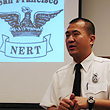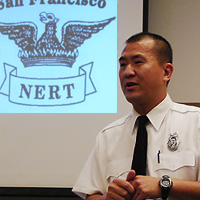UCSF Offers Update on Disaster Preparedness

 |
San Francisco Fire Department Firefighter Ed Chu presented Neighborhood Emergency Response Team training to a group of University Advancment and Planning employees at Laurel Heights on Sept. 7. |
building efforts paid off this spring when San Francisco Office of Emergency Services accepted a UC Police Department (UCPD) liaison in its incident command structure. The San Francisco Hospital Council CEO Committee also has worked with the SFDPH to identify emergency preparedness performance benchmarks and timelines. As a result of concerns expressed by the CEOs to Mayor Gavin Newsom regarding some aspects of City emergency preparedness, the Mayor recently addressed these concerns in an Executive Directive on Emergency Medical Disaster Preparedness. Focus Areas and Goals The steering committee, convened in October 2001 shortly after the Sept. 11, 2001 terrorist attacks, was charged to deliver results on the following key focus areas:
- • Oversee the activities of the management structure established to address the campus' preparedness related to nuclear, biological, chemical, and cyber terrorism;
- • Identify the various facets of biological and chemical terrorism that needed to be addressed by the campus and its affiliated hospitals;
- • Assess the organization's current capacity to respond to nuclear/ biological/ chemical/cyber attacks, and make recommendations on strategies to minimize risks;
- • Identify sites on campus where agents that might be useful in terrorism are stored and make recommendations of methods to secure them;
- • Develop strategies to inform and educate the various constituents of the UCSF community and
- • Develop strategies to coordinate with local, state and federal authorities.
- • Focus efforts to more fully integrate the medical center and campus disaster plans for a better-coordinated response.
- • Strengthen access control for the campus, educating and reinforcing existing policies related to the use of UCSF identification badges and tightening controls and compliance related to security.
- • Continue efforts to improve security and reduce immediate, critical risks to some key physical facilities, including mission-critical information systems.
- • Focus and invest in efforts to improve communication in all areas, with particular emphasis to ensure communication supports coordination across the enterprise.
- • Improve overall emergency preparedness and train and educate the campus community on disaster readiness.
- • Ensure that UCSF lives up to its role and reputation of leadership and as a resource to the region, as well as maintain strong coordinated relationships with local and regional agencies for disaster management.
- • Plan strategically and respond to calls for funding support for UCSF disaster preparedness when available.
- • UCSF Medical Center continues to prepare for and respond to surge capacity requirements or the ability to accept patients at beyond its regular capacity in an emergency. The medical center plan for Parnassus is to accommodate up to 70 disaster victims, including 10 burn or trauma patients. Plans call for transporting less injured patients from Parnassus to the UCSF Medical Center at Mount Zion. Additionally, a preliminary analysis of non-medical center space on the Parnassus campus has been initiated to identify possible locations for aggregating groups of patients.
- • The UCPD has developed an online submission and tracking system to monitor campuswide compliance for emergency action plans. About 80 percent of campus departments/units have submitted these plans.
- • A 2006 training calendar that includes the schedule for hazardous materials for first-receiver training, earthquake drills and preparatory training, trauma training, conferences, and online training links has been widely distributed. Additional online training opportunities are posted at the UCSF Terrorism Information web site.
- • A plan to specifically achieve compliance with National Incident Management Systems mandatory training requirements will be rolled out for 2006-2007. Compliance with this training is required for continued grant eligibility.
- • UCSF Medical Center Infection Control has developed a preliminary communicable disease emergency outbreak plan that specifically addresses surveillance, notifications and alerts, patient isolation and cohorting, personal protective equipment, and mass prophylaxis for medical center staff. Emergency planning for a communicable disease outbreak for the campus community will occur in 2006-2007.
- • The dedicated server, installed to host emergency notifications listservs, is regularly tested and a recent plan to ensure server redundancy to this system as well as the UCSF home page system is being developed. Regular news articles continue to be posted on UCSF Today and the UCSF Terrorism Information website continues to be updated.
- • Last spring, a proposal to develop emergency preparedness curriculum was prepared by a multidisciplinary faculty committee under the leadership of the chair of the Department of Community Health Systems in the UCSF School of Nursing and funded through the UCSF Library's Instructional Improvement Program. A draft curriculum was recently presented to the UCSF Inter-professional Education Task Force and a short introductory course is being considered as a requirement for incoming second-year students.
- • UCPD continues its successful twice-yearly safety fair program bringing information and demonstrations on a variety of safety and emergency preparedness items to the campus community. The next safety fair is scheduled for Thursday, Sept. 14. See story for details.